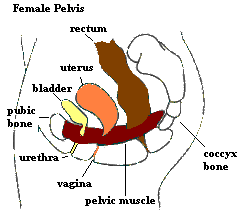H.T. Kurkjian, M.D.
Urinary Incontinence
Hosted by OKdrs.com
_____________________________________________________________________________________
Dr. Kurkjian fast facts and information
[Kurkjian Home][Kurkjian FAQ][Kurkjian Services]
____________________________________________________________________________________
 |
Urinary Incontinence Urinary incontinence is the involuntary leakage of urine. |
There are three kinds of leakage:
- Total urinary incontinence. This condition occurs in patients who have severe damage to the nerves of the bladder or have had prostate surgery for cancer. It can also happen in patients who have had multiple procedures for bladder repair. There are different ways of treating this condition in females. In females, it is worthwhile to repair the bladder with a special procedure called a transpubic urethropexy. In males, most probably, repair with an artificial sphincter is indicated.
- Urgency incontinence. A patient with urgency incontinence may feel a sudden urge to void when urine leaks out of the bladder. Most of the time this is impossible to control. Sometimes the leakage happens with no warning at all. THERE IS NO SURGICAL TREATMENT for this condition. The only therapies are; Bladder relaxants (i.e. Ditropan) and urinary analgesics (i.e. Urised); and Bladder exercises that mostly consist of gradual training in delayed and timed voiding.
- Stress Incontinence. Stress Incontinence is a type of urine
leakage which occurs when a patient coughs, sneezes or jumps. This usually happens
in female patients after multiple vaginal deliveries. The muscles relax and the
bladder sags. The sphincter, the valve that keeps patients from leaking urine, is
now outside the pressure zones of the abdominal cavity. So when they sneeze the pressure
on the bladder is more than the pressure on the valve so leakage results. The
treatment for this condition is Kaegel's exercises - whereby a
patient is asked to exercise the muscles that surround the bladder and the ureter as many
times as possible during the day. In some cases this exercise may straighten the
muscles of the urethra and may help the situation. Medications such
as antihistamines may help in some cases.
Bladder surgery
Endoscopic bladder suspension. This procedure requires a small incision in the skin above the pubic bone. Another incision is made in the vagina and needles are passed from underneath the skin into the vagina. Sutures placed here are pulled up and tied over underneath the skin thus lifting the bladder. The success rate of this is 70% to 75%.
Marshall-Marchetti operation. This procedure is an open surgery where the bladder is lifted up and brought over and tacked to the pubic bone from inside. The success rate on this procedure is 85%.
Transpubic urethropexy. This procedure is similar to the Marshall-Marchetti operation, however, tiny holes are made in the pubic bone and one end of each suture is brought through the pubic bone and tied over the pubic bone lifting the bladder up. The success rate on this is probably between 95% and 98%.
Collagen and Teflon injection. A collagen and teflon paste is injected around the urethra with a special needle in the hope of increasing the resistance to the flow of urine so as to relieve incontinence. The problems with this procedure are:- A foreign substance is being introduced into the body with no idea how long it will last.
- Teflon injected in experimental animals has been shown to migrate to the lungs.
- It is not known if collagen will migrate to the lungs , or what the consequences could be if it does.
- How much to inject and where to inject are questions still to be settled (hit and miss)
- Absorption and deterioration of the collagen is a possibility, since it is know to occur when it is used to treat wrinkles on the face.
- Collagen is very expensive and may cost thousands of dollars.
- It is not known if AIDS can be transmitted using this procedure.
Collagen injection is probably contraindicated in the urgency type incontinence and may make it worse.
Disclaimer: Although OKdrs.com undertakes reasonable efforts to keep the information contained herein accurate, Okdrs.com does not warrant the accuracy, completeness, timeliness or merchantability or fitness for a particular purpose of the information contained herein nor in any way endorse the individuals described herein . In no event shall Okdrs.com be liable to you or anyone else for any decision made or action taken by you in reliance on such information. The above warranties are the only warranties of any kind either expressed or implied including warranties of merchantability or fitness for any particular purpose